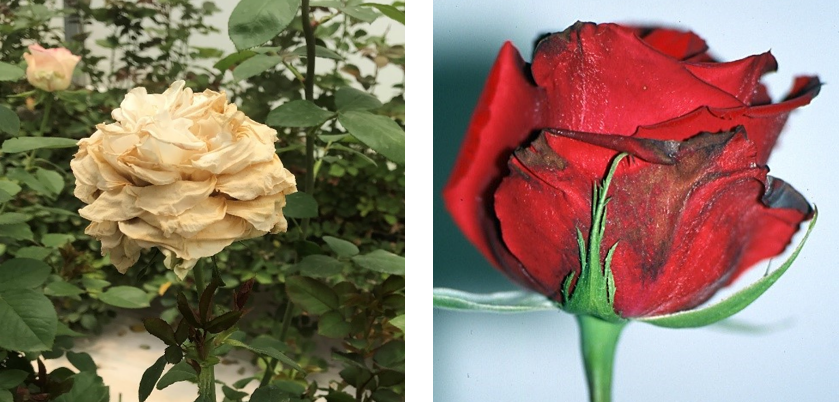Switch off Botrytis with Switch
The most common botrytis blights are those caused by the fungi grouped together as Botrytis cinerea. Botrytis fungi attack a very wide range of hosts, both fields grown crops and those grown under protection. They are also responsible for considerable post-harvest losses of many crops during and after transit or storage. Botrytis cinerea is responsible for the grey mould disease in several ornamental crops including roses, carnations, violet, begonia, chrysanthemum, gerbera, dahlia and geranium reducing both quality and yield. In ornamental crops, yield loss can be total because infected cut flowers are rejected at auctions.
The majority of losses caused by B. cinerea in cut flowers occur in the packing house and during transport to the market. Botrytis cinerea is aggravated by latency of the petal infection, which may not present visible symptoms at the time of flower harvest. Although flowers are handled at temperatures between 2 and 10°C after harvest, higher incidence of B. cinerea has been observed, mainly during transport and storage. Disease control can be difficult because the pathogen can infect several plant parts including flowers, stems, leaves and buds at pre- and post-harvest stages.
Symptoms
Botrytis disease is often called the ‘disease of bad management’ because there are many cultural factors in the control of the grower which could reduce the risk of infection. Botrytis blights can range from leaf spots, stem cankers and root rots to damping-off of young seedlings. Commonly, the blighted tissue will produce prolific brown sporulation. Botrytis can also be called grey mould – which describes.
Usually, Botrytis epidemics occur in cool, wet and humid weather. Infections are encouraged by surface wetness, which, together with temperature drives the life cycle from a latent infection to a sporulating one. Either very young or senescing tissue is susceptible to a Botrytis epidemic –
Between these stages, epidemics are less common. Spores are airborne and produced in vast numbers. Infection can occur by germination of conidia, with penetration through undamaged tissue, stomata or wounds. It may also occur from hyphae growing from dead parts of plants or from other dead plant material in contact with the crop plant. Hyphae growing from petals which have fallen onto lower leaves are a common source of infection.

Rose petals infected with Botrytis cinerea
General IPM of Botrytis
- High levels of sanitation before and during cropping (remove all dead or infected plant material)
- Use disease free planting stock or seed
- Careful handling during transplanting
- Do not wet foliage when irrigating
- Space plants for good air circulation
- Keep humidity low by evacuating warm, moist air at the end of the day and replace with cool, dry air. The cool, dry air should be heated, reducing the RH and thus reduce condensation of water on the plants
- Apply a protective fungicide programme, particularly during ‘risky’ weather.
Chemical control
An effective protectant programme is important as Botrytis is difficult to control once established. Most botrytis fungicides are protectants and since disease cycles can be very fast, many growers adopt a programme of sprays for botrytis control Botrytis is capable of developing fungicide resistance so it’s important to alternate between fungicides with different modes of action.
Two of our broad-spectrum fungicides can form the core of a good protectant programme Switch (cyprodinil + fludioxonil) has outstanding Botrytis control and on-label approval for ornamental plant production and Ortiva (azoxystrobin) can be used under EAMUs. Ortiva’s translaminar movement is useful when it’s hard to target the undersides of leaves with a sprayer.
Two of the active ingredients in these products, the cyprodinil in Switch and the azoxystrobin in Ortiva, move systemically within the plant, which helps fight any latent infection that may be present. Treatments with Switch have demonstrated good efficacy and consistent control of both preharvest and postharvest botrytis in cut flowers.
Switch prevents botrytis spore germination, it prevents germ tube growth from the Botrytis spore, and prevents it from colonizing the leaf tissue. It also contains two fungicides with different modes of action, which make it ideal for use in fungicide resistance management programs.
Together, Switch and Ortiva represent three different mode of action groups. You should alternate these, however, with at least one other active substance, from a different group again, known to be effective on Botrytis – and in any case Ortiva should only be used preventatively to avoid the risk of resistance building up. Other chemical control recommendations are Chorus, Daconil, Ortiva Top and Score.

